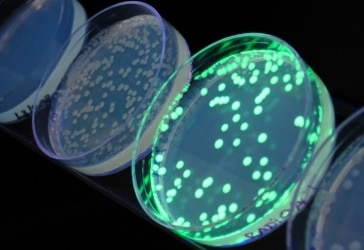Radioactive protein labeling is not as common as it used to be. With the advent of modern protein labeling techniques, such as fluorescence, radioactive labeling has largely fallen out of favor. However, radioactive protein labeling is still a very useful technique and is often superior to more modern labeling techniques.
Radiolabeling can provide a snapshot of the proteins being synthesized and is a highly sensitive protein detection method, much more sensitive than antibody-based detection methods. It is particularly useful for answering questions about protein biosynthesis and turnover in response to cell cycles or stimuli.
Additionally, radioactive labeling is superior to other labeling methods because it avoids many of the common problems associated with other protein labeling methods including spurious fluorescence, enzymatic activity, or steric problems. Therefore, there are many reasons to use this olden but golden protein labeling technique. Read below to learn more.
How to Radioactively Label Your Proteins in General:
Most commonly, proteins are radioactively labeled with 35S. 35S is the radioactive label of choice because its low-energy beta emissions are relatively undamaging to cells, yet readily detectible. Also 35S has a short half-life of 87 days, which minimizes contamination risks. In my lab, we usually introduced 35S into our proteins with 35S-Methionine. We do this for two key reasons:
- Methionine is the only essential amino acid that contains sulfur – this ensures that the radiolabeled methionine will rapidly enter the protein biosynthetic pathway once inside the cells.
- At least one methionine is incorporated into every new protein via its start codon, ensuring all new proteins receive a radiolabel during the incubation period. Other times, we use a mix of 35S-Methionine and 35S-Cysteine to incorporate more radiolabeled amino acids per protein and amplify our signal. This is especially useful when looking at smaller proteins, which may only contain one or two methionine residues.
How to Radioactively Label Your Proteins In Situ:
Depending on your experimental question and the timeframe of protein turnover to be analyzed, radiolabel should be added before, concurrently with, or after a stimulus. During in situ labeling, proteins are usually labeled with 35S-Methionine by simply swapping the normal culture media with culture media spiked with 35S-methionine.
The labeled methionine is rapidly transported into the cells and is immediately incorporated into any newly-synthesizing proteins. At the end of the labeling period, cells are then washed multiple times in normal, radiolabel-free culture media to remove any remaining 35S- Methionine.
After labeling you will need to visualize your radiolabeled proteins. To do this, first you need to lyse your cells and perform a protein extraction. Next you can perform an immunoprecipitation, if needed, to further purify your protein-of-interest. Then last, you will want to run your protein elution on a SDS-PAGE gel, and visualize your separated, radiolabeled protein with autoradiography.
Important note: It is important to remember when introducing radioactivity in this manner that even though 35S is relatively benign all cell culture liquids – including culture media, wash buffers, etc. – must be isolated from other waste streams and disposed of safely and legally!
How to Radioactively Label Your Proteins In Vitro:
If your protein of interest is cytotoxic, has high enzymatic activity, or other biological features that make it difficult to synthesize in cell cultures, you may want to radiolabel your protein in vitro. In vitro or cell-free protein synthesis system allows you to produce relatively large quantities of your protein, with many fewer contaminating cellular proteins, and without degradation products that often carry through from cellular preps.
In vitro radiolabeling is a very straightforward and there are many commercial kits available. Kit details vary but in general an in vitro radiolabeling method looks like this: First, you need to obtain a high-purity DNA or RNA template for the protein of interest. Second, you will add template to your assay mix, which contains buffers, ribosomes, amino acids (including 35S-Met), and DNAse/RNAse inhibitors. Then you will incubate this mix for 30 min to 2 hours. Lastly, after the incubation, you will need to separate your newly-synthesized proteins by SDS-PAGE and visualize them by autoradiography or phosphorimaging.
Safety Tips:
Radioisotopes such as 35S are relatively safe to work with, and require no more heavy-duty shielding than plastic shielding between you and the experimental assay and reagents. However, radiation is still very hazardous and easy to spread around the lab, and is to be avoided.
Radiation contamination can cost your laboratory time, and money; and you, a severely unpleasant lecture from your PI and Safety Department. Additionally, radioactivity is persistent and difficult to completely remove, so be sure to take these simple precautions whenever you use radioactivity:
- Designate an area of your lab for ONLY using radioactivity. Once designated, no “hot” experiments or reagents should ever leave this space. Nor should anyone use any of the reagents or equipment in this space for non-radioactive work. This is to establish a functional barrier that will prevent accidental contamination of other benches, reagents, glassware, and equipment.
- Dispose of liquid wastes appropriately. Designate a large (>1L) glass container at hand for temporary storage of all radioactive liquids – this includes all buffers, washes, and reagents – from your assays even if they have not been in direct contact with the radiolabel. This container should be safely stored away from high-traffic areas of your lab. Liquid waste then must be disposed of through your radiation safety department.
- Dispose of solid waste appropriately. Solid wastes, such as your gloves, are also considered hazardous, and should also be disposed of in a radioactive-specific bin, along with all Eppendorf tubes, pipette tips, etc. that have been exposed to radioactivity.
- Use appropriate safety gear. It should go without saying that in addition to plastic shielding you MUST wear gloves, lab coat and goggles while using radiolabels. While 35S produces relatively weak radiation, it is sufficient to harm you if you ingest it, or if it gets into your eyes or mouth. Therefore, ALWAYS use the correct safety equipment, wash your hands thoroughly after using any hot experiment, and check for contamination using a Geiger counter.
- Forget what your mom tried to teach you – with radiolabels you should NOT clean up your own mess. If you ever spill or accidentally contaminate the lab with radioactivity, DO NOT attempt to clean it up yourself. Instead, call your radiation safety department to come and clean it up for you. Be prepared to tell them the isotope (i.e. 35S) and approximate amount that has spilled, so they will be prepared.







